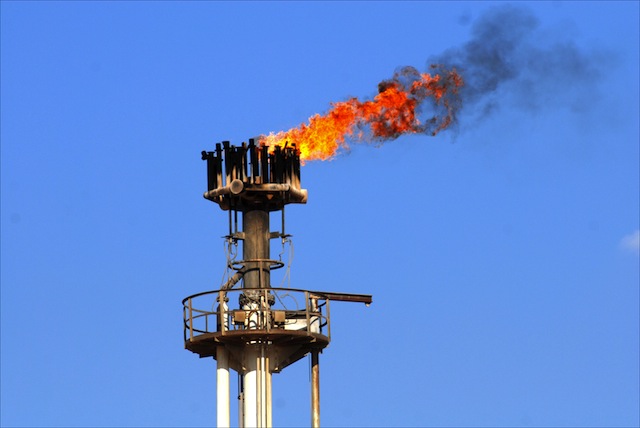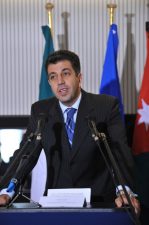
How relevant will OPEC be 10 years from now? Does the rapid expansion of new technologies like fracking threaten the future of eco-friendly energy alternatives such as wind and solar energy?
And would the possible lifting of sanctions against Iran depress oil prices enough — at least in the short term — to hurt the many Arab states that depend on petroleum exports for revenue?
These are among the key issues facing politicians, pundits and corporate bigwigs throughout the Middle East — and all were fodder for discussion during the National Council on U.S.-Arab Relations’ 22nd Annual Arab-U.S. Policymakers Conference.
An energy panel held on the first day of the Oct. 22-23 event brought together five experts: Dr. Herman Franssen, executive director of the Energy Intelligence Group; Sarah Ladislaw, co-director of the energy and national security program at Washington’s Center for Strategic & International Studies; Thomas Graham, executive chairman of the board of directors of Lightbridge Corp.; Shihab Kuran, president of Sun Edison Advanced Solutions, and Kevin Book, co-founder of ClearView Energy Partners LLC.
The panel was moderated by Randa Fahmy Hudome, general counsel for the American-Egyptian Strategic Alliance and former associate deputy secretary of energy.
“This month, we marked the 40th anniversary of the Arab oil embargo,” said Fahmy Hudome, a former U.S. associate deputy secretary of energy. “What has happened since then with U.S. energy policy vis-à-vis the Arab world? Not much, except for this past year. We are now witnessing the most profound changes in energy production and relationships since 1973 — not only in the U.S.-Arab relationship but across the world.”
Franssen certainly agrees with that assessment.
“In the United States, we have made enormous progress that would have been thought impossible 10 years ago. The technology that already existed was perfected, and prices of $100 a barrel made shale gas possible. Today, more than a fourth of our gas production is shale gas,” said the Dutch energy expert, a former adviser to Oman’s Ministry of Petroleum and Minerals. “We are now in a situation where the United States — instead of being a massive importer of liquid natural gas — will most likely be an exporter of LNG, perhaps even a very large one. We could even rival Qatar.”
For a “very long time to come,” said Franssen, the United States will be self-sufficient in gas, and will be able to produce it at relatively low prices compared to any of its rivals. That’s quite a switch from 40 years ago, when American consumers were literally at the mercy of the Arabs and the multinationals that did business with them.
“Prior to 1973, two-thirds of global oil reserves were in the hands of seven giant energy conglomerates known as the ‘seven sisters.’ The events that took place in 1973-74 led to a complete revolution,” said Frassen, referring to the Arab oil embargo sparked by U.S. support of Israel during the Yom Kippur War of October 1973.
OPEC called off the embargo in early 1974, but things were never the same again.
“By then, Middle East oil producers and other OPEC countries had nationalized their resources, so instead of two-thirds of all oil in the hands of the seven sisters, two- thirds were now controlled by national oil companies. That marked the emergence of OPEC as a real power.”
Yet whether the 12-member Organization of Petroleum Exporting Countries is still a “real power” four decades later is debatable.
As Amy Myers Jaffe and Ed Morse wrote in Foreign Policy, the 1970s witnessed “a profound and unprecedented transfer of wealth” to the Middle East that continues to have significant repercussions today — from democracy movements to terrorism and civil wars.
“The region’s leaders failed to set up long-term mechanism to distribute the benefits of that wealth transfer broadly to their populations and to establish an equitable stake in governance of resource proceeds that would have brought a newfound stability to the region,” said the article. “Instead, they bought lavishly, gilding their palaces and buying fleets of luxury autos. For decades, they squandered the opportunity to use oil wealth to modernize their societies and train their populations for future global economic competition. The result — unfolding not just in the Middle East but in other oil-producing countries as well — is a crisis of governance that is itself triggering a round of oil-supply disruptions.”
At the same time, growth in renewable energy has been remarkable. World biofuels production has doubled to more than 1.2 million barrels a day since 2006, while wind power has grown in oil-equivalent terms from one million b/d to two million since 2008. Solar power, meanwhile, jumped from 20,000 b/d of oil-equivalent energy in 2008 to 400,000 b/d last year, according to the article.
In addition, technological advances such as horizontal drilling and hydraulic fracturing — commonly known as “fracking” — have allowed the United States to boost production of shale oil and gas from places like North Dakota and Pennsylvania, while abundant U.S. natural gas is spawning new American-designed engine and modular fueling station technologies to readily use natural gas as a fuel in trucks, trains and ships, ending oil’s monopoly in transport.
So, is OPEC “over a barrel,” as a recent Bloomberg article put it?
Absolutely, writes the article’s author, Meghan O’Sullivan. Besides being largely unsuccessful, OPEC’s most powerful members these days are not interested in preventing huge spikes in world oil prices — nor do they have the ability to inflict similar shocks on the world as they once did.
“The 1973 crisis also launched widespread efforts in the West to find and develop ‘non-OPEC’ oil, to increase energy efficiency, and to bring alternative sources of energy online. OPEC has no self-interest in tanking the fragile economic recoveries of today with high oil prices — or in further catalyzing the already vigorous pursuit of non-oil energy sources,” she wrote.
And that subject is of major concern to the Arab world, which is why energy was the focus of the first panel at last month’s Arab-U.S. Policymakers Conference.

Natural gas is flared from a unit at the Faregh gas complex deep in the Sahara Desert near Jalu, Libya.
“The world is moving to a low-carbon framework, complicating oil, gas and coal,” explained CSIS’s Ladislaw. “We are currently living through the spectrum of this unconventionals revolution. This has reordered the global landscape for new energy investments.”
One of the biggest questions, she said, is how governments around the world will respond to domestic economic difficulties as a result of such a massive shift in the global oil market. “A lot of countries are reassessing their own ability to insulate themselves and become more resilient to a wider array of potential energy futures,” Ladislaw said.
In 1973, OPEC exported two-thirds of its total oil production to Europe and North America. Today, two-thirds of its exports go to Asia — mainly China.
“But the very fact that 50 percent of the world’s oil is in the Middle East ¬— and that it’s the only region in the world with the ability to export most of what it produces — makes it the most important region for the oil industry. It will not be replaced in that role, no matter what we do in North America,” said Frassen.
“The Saudis and others remain the key element in the world of oil. What we are achieving now depends on a number of things,” he said. For one, oil must be priced at a minimum $80 a barrel for “unconventional” oil to be profitable. Secondly, the technology used by the United States must continue to be stable.
Book, a senior associate at CSIS and a member of the National Petroleum Council, spoke of a “possible pivot to Persia” — a reference to what might happen if Congress imposes ever-more stringent sanctions against Iran in an effort to force the regime in Tehran to give up its quest for nuclear weapons.
“We are looking at a very short-term discussion. From the crude risk perspective, this is big but it’s bidirectional: plus or minus one million barrels a day. That’s a big deal for the market,” he said.
Chinese oil workers repair a valve at a rig near Faregh, Libya, deep in the Sahara Desert. The rig is operated by China Oilfield Services Ltd. (COSL).
In the event Congress passes a measure that imposes economic sanctions against the remaining buyers of Iranian oil — China, South Korea, Japan and India — roughly one million barrels would be removed from the world market, pushing up prices to around $114 a barrel from the current $100. On the other hand, oil production in Iraq has skyrocketed by nearly 40 percent since the end of the Iraq War and could reach six million barrels a day by 2020, adding to a potential oil glut. And Iraq can produce oil at a far lower cost than unconventional oil anywhere in North America.
“We can benefit as a producer nation, but we stand to suffer far more than we benefit,” Book said. As a result, we are ill-positioned for all this loose talk about energy independence, in my view. Think about what the world will look like when you yank out 10 million barrels of production a day.”
Arab countries know their black gold will run out someday and have already begun looking for alternative energy supplies for their own rapidly growing populations. Two options being aggressively pursued are nuclear and solar power.
“In the past, there’s been virtually no use of peaceful nuclear power in the Middle East,” said Graham. “Egypt flirted with the idea, and Turkey twice asked for bids to build nuclear power plants, only to have the bidding process fail. Recently, Turkey went ahead and signed an agreement for Russia to build the plant with no money up front, and operate the reactor for 30 years. During that period, receipts from energy production will pay off the construction costs.”
More recently, Saudi Arabia has also indicated that it might build a few reactors, but the United Arab Emirates appears to be the most advanced country in the region when it comes to pursuing a nuclear future.
Yet efforts by the UAE to join the nuclear-power club were frustrated by a controversy that had erupted back in 2006. That year, Dubai Ports World bought British shipping giant P&O. As part of that sale, DP World was to assume the leases of P&O to manage major U.S. port facilities in New York, New Jersey, Philadelphia, Baltimore, New Orleans and Miami, as well as operations at 16 other ports.
However, once the transaction became public, many Democrats in Congress — along with a few powerful Republicans — questioned the deal on the grounds it could make the United States more vulnerable to terrorism. DP World eventually backed off from its plan, transferring operations to an unspecified American entity.
“It was a short-term political firestorm, and it left its mark,” said Graham. “This outcome was wrong and unfair, and was profoundly embarrassing to the UAE — to the point where even though the UAE believed that nuclear energy must be in its future, it proceeded very cautiously down that road, in the wake of Dubai Ports World controversy, knowing that eventually the program would end up being reviewed by Congress.”
As a senior diplomat, Graham — whose Lightbridge Corp. is based in McLean, Va. — helped negotiate every major arms control and non-proliferation agreement from 1970 to 1997 in which the United States was involved. In 2009, he was appointed to the International Advisory Board of the United Arab Emirates.
As such, the UAE established a regulatory agency, the Emirates Nuclear Energy Program, in 2009 and “staffed it with real experts,” he said. Soon after, it awarded a consortium led by Korea Electric Power Co. a $20 billion contract to build the first four nuclear power plants, with a commitment of having the first plant operating by 2017. This past May, construction began on a second plant, to be finished in 2018. If all goes according to plan, two more reactors will be built in 2014 and 2015, for completion in 2019 and 2020. All four will be located in Barakah, a desert site west of Abu Dhabi.
Despite the setbacks to the global nuclear industry which followed Japan’s 2011 Fukushima disaster — the world’s worst nuclear accident since the 1986 meltdown at Chernobyl — Graham insists the mammoth project will pose no threat whatsoever.
“The UAE is the first newcomer country for nuclear power generation in the last three decades,” he said. “It has persevered despite the shadow of Dubai Ports World. It is delivering its reactors on time and on budget. It is committee to the highest standards of safety, security and nonproliferation.”
Yet in the long term, a far cheaper and safer alternative may be solar energy.
Shihab Kuran is president of New Jersey-based Sun Edison Advanced Solutions. Last year, the company he founded, Petra Solar, installed solar panels on 20,000 rooftops throughout Jordan. He also launched the innovative Smart City project in Bahrain.
“Solar energy is one of the fastest-growing sectors in energy today, along with wind,” he said, noting that more than 700 solar sites have been interconnected to date. “The solar industry will receive over $1 trillion in the next seven to eight years, so it’s a massive growth area for us.”
One of solar’s biggest advantages over oil, gas, coal and nuclear energy is that the fuel itself — sunshine — is free.
“But the bulk of the investment is your upfront capital costs, so you have to ensure that you have a long-term view — modeling the megatrends in oil prices and geopolitical stability. With all these arguments for and against solar,” he said, “solar happens to be one of the biggest job generators on a per-megawatt basis.”
Kuran added: “When you look at oil production, the number of jobs are limited. And with nuclear, if you build a nuclear plan in a place like Jordan or Qatar, most likely you will have to import the technology. But with solar, you can build a factory in six to nine months. For a country like Jordan that imports 96 percent of its energy, it’s a straightforward case. You want to be energy-independent? Solar is the answer.”
Top image: Sikh foreman looks on as his workers repair a valve at the Faregh gas complex near Jalu, deep in the Sahara Desert.
All images by Larry Luxner, 2013.





3 thoughts on “Experts at US-Arab Policy Conference debate Mideast’s future as global energy supplier”
Comments are closed.